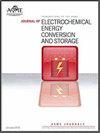Influence of off gas recirculation on the intermediate temperature SOFC with POX reformer
IF 1.9
4区 工程技术
Q3 ELECTROCHEMISTRY
Journal of Electrochemical Energy Conversion and Storage
Pub Date : 2022-08-29
DOI:10.1115/1.4055393
引用次数: 2
Abstract
Solid oxide fuel cell(SOFC) is a clean and efficient energy utilization technology. Partial oxidation reforming(POX) can be used to simplify SOFC system structure, but its lower hydrogen production rate deteriorates system performance. A wise method may be combining anode off gas recirculation(AOGR) and cathode off gas recirculation(COGR) with POX. Thus, their influence on the coupled system of intermediate temperature SOFC and POX is researched in detail in this paper. Results show that the reforming process gradually changes from exothermic to endothermic as AOGR rate increases. Meanwhile, its oxygen demand declines sharply and the process can even be self-sustained without external air input at the AOGR rate of 0.5 and 0.6. The application of AOGR can improve electrical efficiency up to 51%, but at the expense of thermal efficiency. Excessive AOGR rates will result in decreased cell voltage and insufficient energy supply to the after-burner, so it should be restricted within a reasonable range and the best recommended value is 0.5. The application of COGR has little effect on fuel line parameters, so it cause little deterioration in electrical efficiency while improving thermal efficiency. Besides, cell voltage is also insensitive to it. The combination of AOGR and COGR can obtain better fuel economy and larger cogeneration scale simultaneously at the cost of a tiny electrical output power, while an optimal balance between three efficiencies is also achieved.烟气再循环对POX重整炉中温SOFC的影响
固体氧化物燃料电池(SOFC)是一种清洁高效的能源利用技术。部分氧化重整(POX)可以简化SOFC体系结构,但其较低的产氢率使系统性能下降。一种明智的方法可能是将阳极排气再循环(AOGR)和阴极排气再循环(COGR)与POX相结合。因此,本文详细研究了它们对中温SOFC和POX耦合系统的影响。结果表明,随着AOGR速率的增加,重整过程逐渐由放热向吸热转变。同时,其需氧量急剧下降,在AOGR率为0.5和0.6时,该过程甚至可以在没有外部空气输入的情况下自我维持。AOGR的应用可以提高高达51%的电效率,但以牺牲热效率为代价。过高的AOGR率会导致电池电压下降,后燃烧器的能量供应不足,因此应限制在合理范围内,最佳推荐值为0.5。COGR的应用对燃油管路参数影响不大,因此在提高热效率的同时,对电效率的影响不大。此外,电池电压对其也不敏感。AOGR和COGR结合使用,可以以很小的输出功率为代价,同时获得更好的燃油经济性和更大的热电联产规模,同时实现了三种效率的最佳平衡。
本文章由计算机程序翻译,如有差异,请以英文原文为准。
求助全文
约1分钟内获得全文
求助全文
来源期刊

Journal of Electrochemical Energy Conversion and Storage
Engineering-Mechanics of Materials
CiteScore
4.90
自引率
4.00%
发文量
69
期刊介绍:
The Journal of Electrochemical Energy Conversion and Storage focuses on processes, components, devices and systems that store and convert electrical and chemical energy. This journal publishes peer-reviewed archival scholarly articles, research papers, technical briefs, review articles, perspective articles, and special volumes. Specific areas of interest include electrochemical engineering, electrocatalysis, novel materials, analysis and design of components, devices, and systems, balance of plant, novel numerical and analytical simulations, advanced materials characterization, innovative material synthesis and manufacturing methods, thermal management, reliability, durability, and damage tolerance.
 求助内容:
求助内容: 应助结果提醒方式:
应助结果提醒方式:


